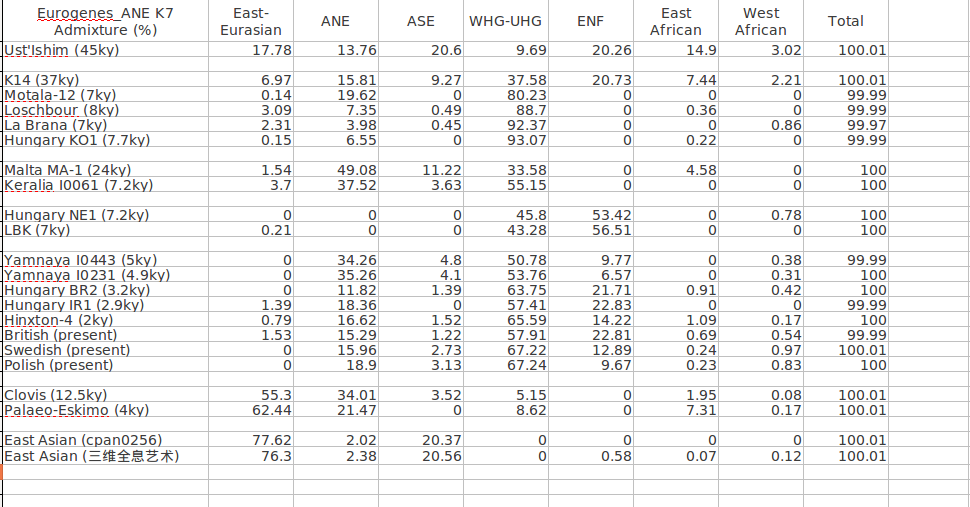wegene数据与古人类DNA的对比
对比自己的wegene数据与古人类DNA的意义重大。如果您已经的有了原始数据,请上载到GEDmatch(www.gedmatch.com),wegene数据需要先压缩成zip文件。然后在Analyze Your Data->DNA raw data->Admixture (heritage)->Eurogenes->选择Admixture Proportions (With link to Oracle),即可得到您的ANE_K7计算结果。相关的古人类DNA的ANE_k7详细对比请见http://ranhaer.s47-56.myverydz.com/thread-30817-1-1.html
请大家分享对比结果,我的结果是图中的三维全息艺术。
请大家分享对比结果,我的结果是图中的三维全息艺术。



12 个回复
赞同来自: 蓝星旗 、田园牧歌 、blackman6688 、黄隆思 、jianjinhanzhi 、墨存更多 »
Ancestral South Eurasian (ASE): this is a really basal cluster that peaks in tribal groups of Southeast Asia. It's probably very similar in some ways to the Ancestral South Indian (ASI) component described by Reich et al. a few years ago.
赞同来自: 田园牧歌
Reconstructing population history in East Asia
Chuan-Chao Wang1 ,3, Nadin Rohland1, Shop Mallick1, Longli Kang6, Shi Yan2, Rukesh Shrestha2,
Shaoqing Wen2, Oleg Balanovsky5, Elena Balanovska5, Yuri Bogunov5, Qiongying Deng7, Hongbing
Yao8, Kumarasamy Thangaraj10, Lalji Singh10, Rong Lin9, Wangwei Cai9, Dongna Li9, Ling-Xiang Wang2,
Manfei Zhang2, Lan-Hai Wei2, Alexander Kim1, Pontus Skoglund1, Iosif Lazaridis1, Iain Mathieson1,
Stephan Schiffels3, Wolfgang Haak3, Chris Stringer11, Nick Patterson1, Li Jin2, Alexander N Popov4, Hui
Li2, Johannes Krause3, David Reich1
1 Department of Genetics, Harvard Medical School, Boston, Massachusetts, USA,
2 MOE Key Laboratory of Contemporary Anthropology, School of Life Sciences, Fudan University, Shanghai,
China,
3 Department of Archaeogenetics, Max Planck Institute for the Science of Human History, Jena, Germany,
4 Scientific Museum, Fareastern Federal University, Vladivostok, Russia,
5 Vavilov Institute of General Genetics and Research Centre for Medical Genetics, Russian Academy of Sciences, Moscow, Russia,
6 Key Laboratory of High Altitude Environment and Gene Related to Disease of Tibet, Ministry
of Education, Tibet University for Nationalities, Xianyang, Shaanxi, China,
7 Department of Anatomy,Guangxi Medical University, Nanning, Guangxi, China,
8 Key Laboratory of Evidence Science of Gansu Province, Gansu Institute of Political Science and Law, Lanzhou, Gansu, China,
9 Department of Biology, Hainan Medical College, Haikou, Hainan, China,
10 Centre for Cellular and Molecular Biology,Hyderabad, India,
11 Department of Earth Sciences, The Natural History Museum, London, UK
The deep population history of East Asia remains poorly understood compared to that of West Eurasia,
due to the lack of ancient DNA data as well as limited sampling of present-day populations especially
on the Tibetan Plateau and in southern China. We report a fine scale survey of East Asian history based
on genome-wide data from ancient samples in the Amur River Basin, as well as 435 newly reported
individuals from 53 populations. Present-day groups can be broadly classified into highly
differentiated clusters, corresponding to Amur River Basin, Tibetan Plateau, southern natives and Han
Chinese. Populations of the Amur River Basin show a high degree of genetic continuity from seven
thousand years ago until today, and are closely related to the strain of East Asian related ancestry
present in Native Americans. Tibetan Plateau populations are all admixed, deriving about 5%-10% of
their ancestry from an anciently divergent population that plausibly corresponds to the Paleolithic
population on the Plateau, and the remaining part from an ancient population that no longer exists in
unmixed form but that likely corresponds to expanding farmers from the Middle and Upper Yellow
River Basin who also contributed 40-90% of the ancestry of Han Chinese. A total of 10-60% of Han
Chinese ancestry derives from southern Native populations, and we show that the type of southern
Native ancestry that contributed to Taiwan Island Austronesian speakers is most closely related to
present-day speakers of Tai-Kadai languages in southern mainland China.
赞同来自: 费力科思
赞同来自: ASDQZXknbvf
赞同来自:
赞同来自:
赞同来自:
那两位怎么看待这两幅图中的TB和CHB(或者说N-Han)的关系:
http://www.plosgenetics.org/article/info%3Adoi%2F10.1371%2Fjournal.pgen.1001116
http://www.plosone.org/article/info:doi/10.1371/journal.pone.0017002
>>PloSOne这篇很明显啊汉藏紧密聚类,说明汉藏遗传近缘。
@wang 那王兄怎么解释第二幅图中Tibetan跟Northern Chinese比Yi(彝)和Lahu(拉祜。体质分类上属典型南亚类型)甚至Cambodian跟Northern Chinese还远?
赞同来自:
1、既然是祖源,“祖”到什么程度,必然有个时间尺度,现代人群基本都是在新石器时期开始形成的,重点必然放在这个时间段内;当然上推到万年前,可以用来分析更早的人类演化情况,例如其他古人类与现代智人的融合情况、现代智人的迁徙情况等,但没有新石器古DNA来的直接。
2、汉族前身华夏族的形成时间,目前广为接受的说法于3000~4000年前开始、秦汉时基本形成,用这个时间段的古DNA是最能说明问题的,因为是实打实的材料,但各祖先人群的时间应该大致统一,或者有证据表明前后没有太多变化;其他民族的形成时间更短,分析情况同理,但时间上就长不就短、也可以用这个时间段的古DNA。
3、关于祖先人群的选择:
(1)原始汉藏人群肯定是现代汉族的重要源头之一,这个从语言和Y都有很多证据,而到了3000年,原始汉藏人群应该已经分化了,至于超哥所说的3000年前的古藏人,不知道是否指尼泊尔chokhopani的那例,藏族祖先已经进入高原腹地并很可能与当地的土著发生了融合或经历了强烈的自然选择或经历瓶颈发生漂变,所以以此来代表分化后的华夏族祖先成分,可能会有些问题吧,但目前没有3000年左右确实的原始汉藏分化后形成的华夏族祖先方面的古DNA(渭水中上游、陇东、陕北一带),也是聊胜于无,或许可以结合其他例如高原适应方面的数据、admixture分析来剔除相关成分?
(2)期待同期商人或更早期的中国东南西北中古DNA
赞同来自:
赞同来自:
赞同来自:
要回复问题请先登录或注册